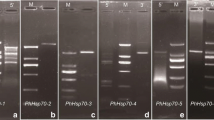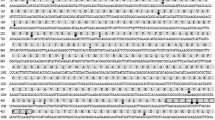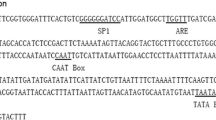Abstract
Heat shock proteins and molecular chaperones are key components contributing to survival in the abiotic stress response. Porphyra seriata grows on intertidal rocks exposed to dynamic environmental changes associated with the turning tides, including desiccation and heat stress. Analysis of the ESTs of P. seriata allows us to identify the nine HSP cDNAs, which are predicted to be PsHSP90, three PsHSP70, PsHSP40 and PsHSP20, and three 5′-truncated HSP cDNAs. RT–PCR results show that most of the PsHSP transcripts were detected under normal cell growth conditions as well as heat stress, with the exception of two cDNAs. In particular, PsHSP70b and PsHSP20 transcripts were upregulated by heat stress. When the putative mitochondrial PsHSP70b was introduced and overexpressed in Chlamydomonas, transformed Chlamydomonas evidenced higher rates of survival and growth than those of the wild type under heat stress conditions. Constitutive overexpression of the PsHSP70b gene increases the transcription of the HSF1 as well as the CrHSP20 and CrHSP70 gene. These results indicate that PsHSP70b is involved in tolerance to heat stress and the effects on transcription of the CrHSP20 and CrHSP70 genes.






Similar content being viewed by others
References
Alvim FC, Carolino SMB, Cascardo JCM, Nunes CM, Martinez CA, Otoni WC, Fontes EPB (2001) Enhanced accumulation of BiP in transgenic plants confers tolerance to water stress. Plant Physiol 126:1042–1054
Blouin NA, Brodie JA, Grossman AC, Xu P, Brawley SH (2011) Porphyra: a marine crop shaped by stress. Trends Plant Sci 16:29–37
Boston RS, Viitanen PV, Vierling E (1996) Molecular chaperones and protein folding in plants. Plant Mol Biol 32:191–222
Bray EA, Bailey-Serres J, Weretilnyk E (2000) Responses to abiotic stresses. In: Buchanan B, Gruissem W, Jones R (eds) Biochemistry and molecular biology of plants. American Society of Plant Biologists, Rockville, pp 1158–1203
Cazale A-C, Clement M, Chiarenza S, Roncato M-A, Pochon N, Creff A, Marin E, Leonhardt N, Noel L (2009) Altered expression of cytosolic/nuclear Hsc70-1 molecular chaperone affects development and abiotic stress tolerance in Arabidopsis thaliana. J Exp Bot 60:2653–2664
Feder ME, Hofmann GE (1999) Heat-shock proteins, molecular chaperones, and the stress response: evolutionary and ecological physiology. Annu Rev Physiol 61:243–282
Fink AL (1999) Chaperone-mediated protein folding. Physiol Rev 79:425–449
Frydman J (2001) Folding of newly translated proteins in vivo: the role of molecular chaperones. Annu Rev Biochem 70:603–647
Fu W, Yao J, Wang X, Liu F, Fu G, Duan D (2009) Molecular cloning and expression analysis of a cytosolic HSP70 gene from Laminara japonica (Laminariacease, Phaeophyta). Mar Biotechnol 11:738–747
Guy CL, Li QB (1998) The organization and evolution of the spinach stress 70 molecular chaperone gene family. Plant Cell 10:539–556
Han W, Christen P (2003) Mechanism of the targeting action if DnaJ in the DnaK molecular chaperone system. J Biol Chem 278:19038–19043
Harris EH (1989) The Chlamydomonas sourcebook: a comprehensive guide to biology and laboratory use. Academic, San Diego
Hartl FU (1996) Molecular chaperones in cellular protein folding. Nature 381:571–579
Hartl FU, Hayer-Hartl M (2002) Molecular chaperones in the cytosol: from nascent chain to folded protein. Science 295:1852–1858
Hemmingsen SM, Woolford C, van der Viles SM, Tily K, Dennis DT, Georgopoulos CP, Hendrix RW, Ellis RJ (1988) Homologous plant and bacterial proteins chaperone oligomeric protein assembly. Nature 333:330–334
Hennessy F, Nicoll WS, Zimmermann R, Cheetham ME, Blatch GL (2005) Not all J domains are created equal: implications for the specificity of HSP40–HSP70 interaction. Protein Sci 14:1697–1709
Hwang MS, Chung IK, Oh YS (1997) Temperature responses of Porphyra tenera Kjellman and P. yezoensis Ueda (Bangiales, Rhodophyta) from Korea. Algae 12:207–213
Hwang MS, Kim SM, Ha DS, Baek JM, Kim HS, Choi HG (2005) DNA sequences and identification of Porphyra cultivated by natural seeding on the southwest coast of Korea. Algae 20:183–196
Ireland HE, Harding SJ, Bonwick GA, Jones M, Smith CJ, Williams JHH (2004) Evaluation of heat shock protein 70 as a biomarker of environmental stress in Fucus serratus and Lemna minor. Biomarkers 9:139–155
Jolly C, Morimoto RI (1999) Stress and the cell nucleus: dynamics of gene expression and structural reorganization. Gene Expr 7:261–270
Kampinga HH, Brunsting JF, Stege GJ, Burgman PW, Konings AW (1995) Thermal protein denaturation and protein aggregation in cells made thermotolerant by various chemicals: role of heat shock proteins. Exp Cell Res 219:536–546
Kang PJ, Ostermann J, Shilling J, Neupert W, Craig EA, Pfanner N (1990) Requirement for HSP70 in the mitochondria matrix for translocation and folding of precursor protein. Nature 348:137–143
Karlin S, Brocchieri L (1998) Heat shock protein 70 family: multiple sequence comparisons, function, and evolution. J Mol Evol 47:565–577
Kim E, Park HS, Jung YJ, Jeong WJ, Park HS, Hwang MS, Park EJ, Gong YG, Choi DW (2011) Identification of the high-temperature response genes from Porphyra seriata (Rhodophyta) ESTs and enhancement of heat tolerance of Chlamydomonas (Chlorophyta) by expression of the Porphyra HTR2 gene. J Phycol 47:821–828
Kindle KL (1990) High-frequency nuclear transformation of Chlamydomonas reinhardtii. Proc Natl Acad Sci USA 87:1228–1232
Krishna P, Gloor G (2001) The HSP90 family of proteins in Arabidopsis thaliana. Cell Stress Chaperones 6:238–246
Leborgne-Castel N, Jelitto-Van Dooren DPWM, Crofts AJ, Denecke J (1999) Overexpression of BiP in tobacco alleviates endoplasmic reticulum stress. Plant Cell 11:459–470
Lee JH, Hubel A, Schoffl F (1995) Depression of the activity of genetically engineered heat shock factor causes constitutive synthesis of heat shock proteins and increased thermotolerance in transgenic Arabidopsis. Plant J 8:603–612
Liberek K, Marszalek J, Ang D, Georgopoulos C, Zylicz M (1991) Escherichia coli DnaJ and GrpE heat shock proteins jointly stimulate ATPase activity of DnaK. Proc Natl Acad Sci USA 88:2874–2878
May T, Soll J (2000) 14-3-3 proteins form a guidance complex with chloroplast precursor proteins in plants. Plant Cell 12:53–64
Mayer MP, Bukau B (2005) HSP70 chaperones: cellular functions and molecular mechanism. Cell Mol Life Sci 62:670–684
McLachlan J (1973) Growth media—marine. In: Stein JR (ed) Handbook of Phycological methods. Cambridge University Press, New York
Michaud S, Marin R, Westwood JT, Tanguay RM (1997) Cell-specific expression and heat-shock induction of HSPs during spermatogenesis in Drosophila melanogaster. J Cell Sci 110:1989–1997
Miernyk JA (1997) The 70 kDa stress-related proteins as molecular chaperones. Trends Plant Sci 2:180–187
Miura A (1988) Taxonomic studies of Porphyra species cultivated in Japan, referring to their transition to the cultivated variety. J Tokyo Univ Fish 75:311–325
Morimoto RI (1998) Regulation of the heat shock transcriptional response: cross talk between a family of heat shock factors molecular chaperones, and negative regulators. Genes Dev 12:3788–3796
Nelson RJ, Ziegelhoffer T, Nicolet C, Werner-Washburne M, Craig EA (1992) The translation machinery and 70 kD heat shock protein cooperate in protein synthesis. Cell 71:97–105
Ono K, Hibino T, Kohinata T, Suzuki S, TanakaY NT, Takabe T, Takabe T (2001) Overexpression of DnaK from a halotolerant cyanobacterium Aphanothece halophytica enhances the high-temperature tolerance of tobacco during germination and early growth. Plant Sci 160:455–461
Rabindran SK, Haroun RI, Clos J, Wisniewski J, Wu C (1993) Regulation of heat shock factor trimer formation: role of a conserved leucine zipper. Science 259:230–234
Renner T, Waters ER (2007) Comparative genomic analysis of the HSP70s from five diverse photosynthetic eukaryotes. Cell Stress Chaperones 12:172–185
Richter K, Buchner J (2001) HSP90: chaperoning signal transduction. J Cell Physiol 188:281–290
Sabehat S, Lurie D, Weiss (1998) Expression of small heat-shock proteins at low temperatures—a possible role in protecting against chilling injuries. Plant Physiol 117:651–658
Sahoo D, Tang X, Yarish C (2002) Porphyra—the economic seaweed as a new experimental system. Curr Sci 83:1313–1316
Sangwan V, Orvar BL, Beyerly J, Hirt H, Dhindsa RS (2002) Opposite changes in membrane fluidity mimic cold and heat stress activation of distinct plant MAP kinase pathways. Plant J 31:629–638
Scharf KD, Siddique M, Vierling E (2001) The expanding family of Arabidopsis thaliana small heat stress protein and a new family of proteins containing α-crystallin domains (Acd proteins). Cell Stress Chaperones 6:225–237
Schroda M, Vallon O (2009) Chaperones and proteases. In: Stern DB (ed) Chlamydomonas source book 2nd edition, vol volume 2. Elsevier, San Diego
Schulz-Raffelt M, Lodha M, Schroda M (2007) Heat shock factor 1 is a key regulator of the stress response in Chlamydomonas. Plant J 52:286–295
Sorger PK, Nelson HC (1989) Trimerization of a yeast transcriptional activator via a coiled-coil motif. Cell 59:807–813
Soto A, Allona I, Collada C, Guevara MA, Casado R, Rodriguez-Cerezo E, Aragoncillo C, Gomez L (1999) Heterologous expression of a plant small heat-shock protein enhances Escherichia coli viability under heat and cold stress. Plant Physiol 120:521–528
Sugino M, Hibino T, Tanaka Y, Nii N, Takane T, Takabe T (1999) Overexpression of DnaK from a halotolerant cyanobacterium Aphanothece halophytice acquires resistance to salt stress in transgenic tobacco plants. Plant Sci 146:81–88
Sung DY, Guy CL (2003) Physiological and molecular assessment of altered expression of Hsc70-1 in Arabidopsis. Evidence for pleiotropic consequences. Plant Physiol 132:979–987
Sung DY, Kaplan F, Guy CL (2001a) Plant HSP70 molecular chaperones: protein structure, gene family, expression and function. Physiol Plant 113:443–451
Sung DY, Vierling E, Guy CL (2001b) Comprehensive expression profile analysis of the Arabidopsis HSP70 gene family. Plant Physiol 126:789–800
Tanaka KI, Namba T, Arai Y, Fujimoto M, Adachi H, Sobue G, Takeuchi K, Nakai A, Mizushima T (2007) Genetic evidence for a protective role for heat shock factor 1 and heat shock protein 70 against colitis. J Biol Chem 282:23240–23252
Tominaga H, Coury DA, Amno H, Kakinuma M (2010) Isolation and characterization of a cDNA encoding a heat shock protein 70 from a sterile mutant of Ulva pertusa (Ulvales, Chlorophyta). Ecotoxicology 19:577–588
Tomoyasu T, Ogura T, Tatsuta T, Bukau B (1998) Level of DnaK and DnaJ provide tight control of heat shock gene expression and protein repair in Escherichia coli. Mol Microbiol 20:567–581
Vierling E (1991) The roles of heat shock proteins in plants. Annu Rev Plant Physiol Plant Mol Biol 42:579–620
Wang W, Vinocur B, Shoseyov O, Altman A (2004) Role of plant heat-shock proteins and molecular chaperons in the abiotic stress response. Trends Plant Sci 9:244–252
Acknowledgments
This research was supported by a grant (RP-2011-BT-031) from National Fisheries Research and Development Institute, Korea. We would also like to thank Chun Ji Yin for his support with the transformation of Chlamydomonas.
Author information
Authors and Affiliations
Corresponding author
Additional information
Hong-Sil Park and Won-Joong Jeong equally contributed to this paper.
Rights and permissions
About this article
Cite this article
Park, HS., Jeong, WJ., Kim, E. et al. Heat Shock Protein Gene Family of the Porphyra seriata and Enhancement of Heat Stress Tolerance by PsHSP70 in Chlamydomonas . Mar Biotechnol 14, 332–342 (2012). https://doi.org/10.1007/s10126-011-9417-0
Received:
Accepted:
Published:
Issue Date:
DOI: https://doi.org/10.1007/s10126-011-9417-0




